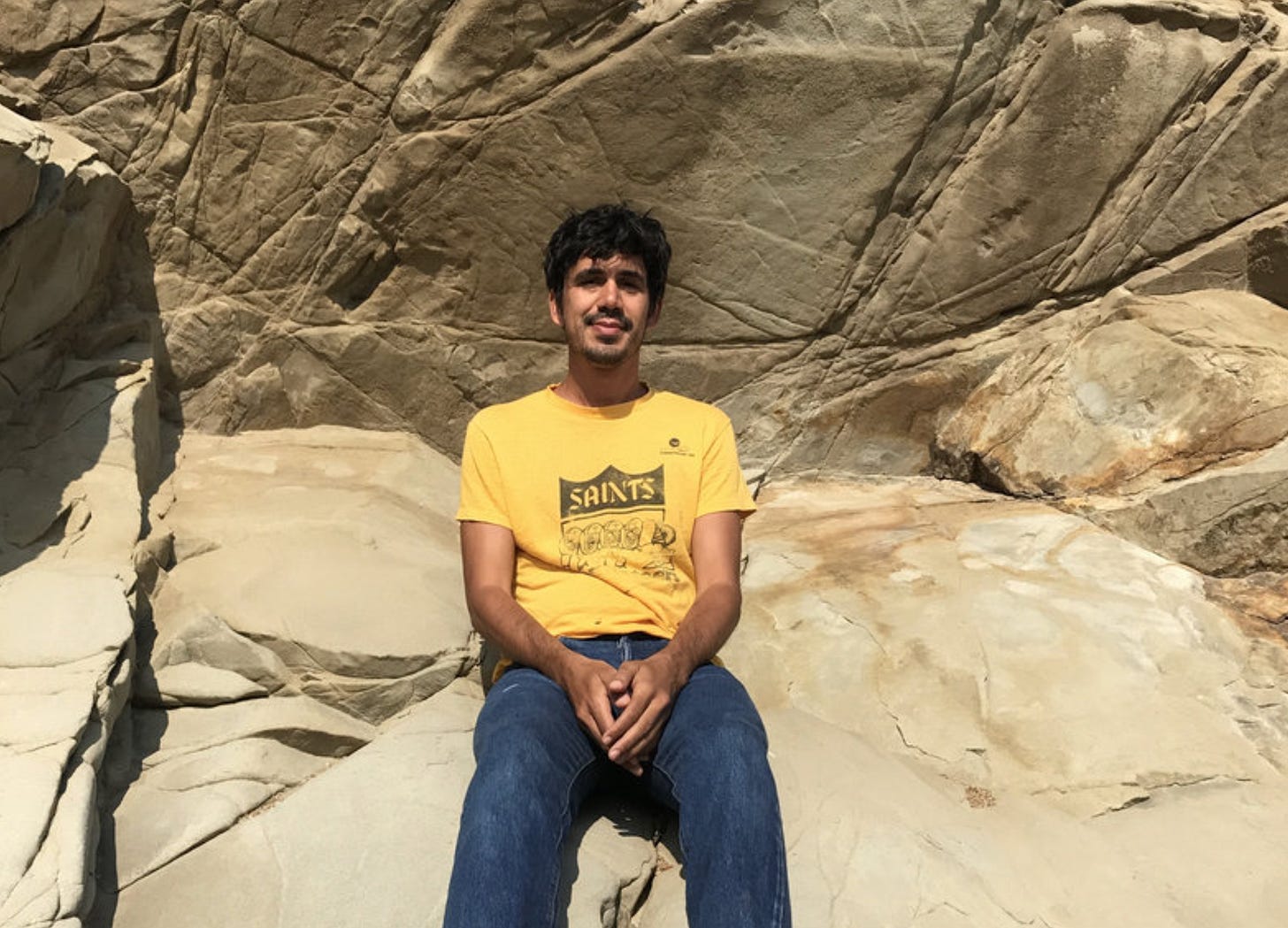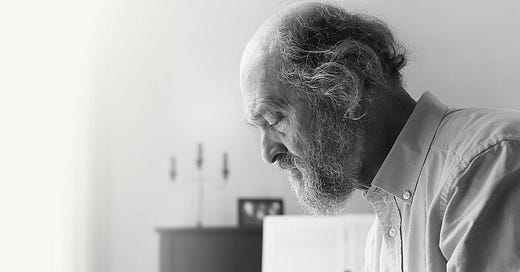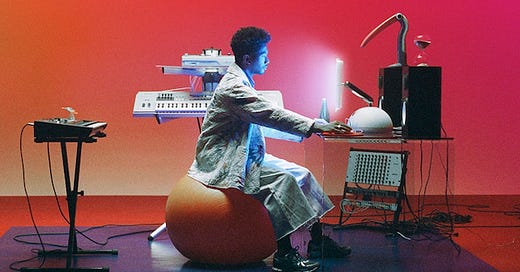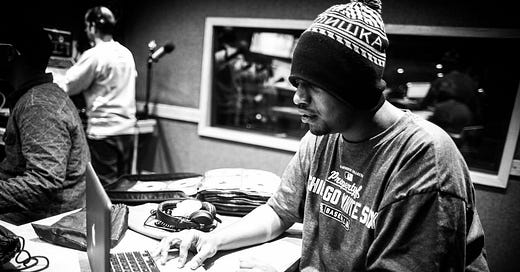
Today we’re listening to Ofir Ganon, a Middle Eastern guitarist and composer based in Brooklyn. He grew up in a Moroccan-Jewish commune, where he internalized Arabic/North African melodies as sung by relatives. He first picked up his uncle’s bass when he was five, then later traded it in for a guitar, taking lessons with an older classmate. He moved to Brooklyn in 2004 and collaborated frequently as a live session player, eventually making his own solo guitar recordings in the mid-2010s. We’re first playing his new album, Same Air, which combines a kind of acoustical bareness with mystical progressions. “That’s what makes him and his playing such an enigma,” observed Delicate Steve. “I simply don’t know anyone who has a more natural style than he does.” We’re also playing his 2016 debut LP, Pollen/Promises. Both records reminded us heavily of Branko Mataja, whom he cited as an influence in our conversation which follows the streaming links.
Same Air - Ofir Ganon (32m, no vocals)
Spotify / Apple Music / YouTube Music / Amazon Music / Bandcamp / Tidal
Pollen/Promises - Ofir Ganon (33m, vocals on track 4)
Spotify / Apple Music / YouTube Music / Amazon Music / Bandcamp / Tidal
What's your earliest memory of music?
There are a couple: One is of my grandmother who was a tailor and would work on the sewing machine all day. When I was very young (around three years old), she’d sit me by a big window and play very sad, long Arabic ballad-esque songs off of her little radio. She grew up in Morocco, so she would play me artists like Um Kultum and Farid El Atrash. Each of their songs is like a long story that is sung in a very emotional style – almost a kind of crying – with long-sustained and vibrating vocals. It’s often scored by a mini orchestra and is still very popular music in the Middle East. I would definitely classify it as “adult music” music; it would make me so sad as a child, and I couldn’t even understand what they were singing about.
The other memory is from the village I grew up in, a Moroccan farming commune in Israel, from songs specifically meant for observing Yom Kippur at the synagogue. Prayers were led by someone called the “Hazzan” (or a Cantor in English) who is the “lead singer” if you will. They are followed by about ten other vocalists who sing specific verses, each with their own unique vocal tone. I consider it similar to the way rap groups from the ‘90s were structured. There would be parts where the whole synagogue joined in a call-and-response. All of the voices singing together in harmony in the haunting and mesmerizing Arabic/North African scales struck me at my core. Actually, on Same Air, I’ve transcribed some of the chants on from those memories on the tracks “Miel” and “Neilah”.
Tell us about starting to play the guitar. Did you take lessons? And what early music did you hear that motivated you to play?
There were no musicians in my family, but for some reason my uncle had a bass he never played that I picked up when I was six. I remember putting it on my lap and instantly figuring out the main melody/riff to “Summer Nights” from Grease on a single string. I didn’t really start to play until much later on, when I was starting high school around 14 or 15 years old. My middle and high school was an art school, and even though I was in the graphics and painting department, they had a music department that my friends were all in, so I ended up hanging out with that crew all day at their practices.
My closest friend played bass, but there was this older kid who I thought was so cool and was a phenomenal guitar player (I’m still amazed by how incredible he was honestly). I was so inspired by his talent, especially because he looked so cool to me as the only kid with long hair like a kid straight out of the ‘70s. Hearing and seeing him play made me want to pick up the guitar.
Eventually, my brother traded my uncle’s bass for a classical guitar that someone had put an incomplete set of steel acoustic strings on. I played it to death, but it was definitely a rare challenge to start on. One day my brother’s friend noticed how much I was playing and offered to let me borrow his electric guitar. He even rigged it to a little janky amp that was made out of a stereo speaker and some old peavey head with a metal cabinet handle for me.
Once I got set up with that guitar, I asked the older kid from school who lived in my village to give me lessons. He knew how to disassemble a guitar, put it back together again, and set it up for exactly what he needed. Witnessing him take apart and lay out each component of the instrument demystified the guitar for me and gave me a different kind of confidence with the instrument, like how guys who race cars know to fix each part of the engine. I restore vintage guitars and work as a guitar tech now, so I guess the experience has come full circle.
While he was teaching me the basics, he turned me onto all sorts of obvious guitar players like Hendrix, Beck, Jaco. I was also listening to the Middle Eastern guitar heroes like Aris San, Omar Khorshid, and Yehuda Keisar. At the same time, there was a documentary about the history of the blues, jazz, and rock & roll that was playing on TV, so I got deep into early Delta / Mississippi Blues music.
You make really beautiful instrumental guitar music. What artists / albums helped attract you to this style?
Thank you! From the moment I first picked up the guitar, I heard musical composition ideas in my head and tried to figure out how to play them. When I moved to the U.S. and started playing with bands, the music I was writing for myself didn’t feel like it fit into that context. My first girlfriend in NYC, a very talented painter and artist, introduced me to avant-garde, experimental, and film music. We were living together, and she was the only one who would hear me play my own music and encouraged me to perform my own stuff. She also opened my eyes to composers like Teiji Ito, Moondog, and John Cage, who broadened my imagination even further. Being in NYC at that time was a gift because you could still go and see a lot of underground music, free improv, jazz, and noise shows where I saw examples of less conventional music being played live. The combination of that exposure and her support finally gave me the confidence to start playing solo live.
I was also very inspired by stand-up comedians. I used to work at a 24/7 coffee shop across from the Comedy Cellar (around 2005-07) and would meet all these great comedians like Dave Attell, Gary Gulman, and Doug Stanhope and go check them out. I love the standup artform. There’s no hiding, and you must “bomb” in front of audience to have a chance of being truly great. I just loved how vulnerable and spare the setup is: just a person and a microphone.
Some of my notable albums and artists: Branko Mataja’s Over Fields and Mountains, Boubacar Traoré’s KarKar, Philip Glass’ Glassworks, Marc Ribot’s Silent Movies, Arto Lindsay playing solo live, Zach Hill playing solo live, and Vincent Gallo’s When.
What's your studio setup, like what gear and instruments do you use?
For amps, I have a Fender ‘58 Deluxe, ‘56 Harvard, and a ‘57 Champ. After owning pretty much every Fender amp from tweed to silver face era, these are the ones that work best for me. I’ve made some specific mods to them like swapping in certain NOS tubes. I personally prefer Alnico magnets and do my best to match speaker wattage as closely as possible to amp wattage, which gives a much more touch-sensitive and lively response.
For guitars, I only have three at the moment. I have it narrowed it down to a bare minimum these days. My main one is a ‘61 Telecaster with a ‘63 neck. That guitar is very special, though it’s hard to explain why; it just does exactly what I need it to. I use a ’57 Tele as a backup of sorts to the ’61, which I just got recently. It sounds very different, but in a way that I appreciate. I also have a 12-string electric Danelectro “Scorpion” from the ’60s, which is unique-sounding and quite rare. They’re considered Arto Lindsay’s signature guitar, and we actually connected and became friends because of our love for these guitars. He now has two of the first ones I ever bought. The one I have now is going to be with me until the end : ).
I used to have all sorts of recording gear for an at-home set up, but I sold basically everything when I started working at studios. As a tech, I get execs to record in some amazing studios. I recorded Same Air at Figure 8 Studio in Brooklyn, NY in their main studio that has two rooms that can be isolated. They have every microphone you can dream of and a Neve 5316 board. We recorded direct to a 2” tape machine called a Studer a827 and mixed live on the Neve. Michael Coleman did an amazing job sound engineering and mixing it.
One of the techniques we used was inspired by Branko Mataja’s method of getting a delayed octave effect by doubling the signal in a desirable lag time based on the wet-only delay time setting with a single repeat, then transitioning into a wet-only octave up or down. I used an early Boss DD-2 pedal because it has a clear sounding repeat; the analog ones I tried were all too dark. I had one amp (a ‘58 Deluxe) next to me in the main room for the dry sound, and then a rotating, second amp in the other room for the wet sound: either the Harvard, a Princeton reverb, or the Deluxe reverb. We used three or four mics on each amp.
How do you discover new music these days? And how do you listen to music?
I normally find new things through friends or by going into record stores and browsing the New Arrivals section. If I’m out, I’m listening on my phone’s wired headphones. If I’m at home, I have U-Turn turntable that’s hooked up to some JBL speakers. Nothing too fancy, but it sounds good.
Name an underrated artist from the past 50 years.
Ted Lucas
What are you working on next?
I actually just headed upstate to record my next album at a great studio in the Catskills called The Outlier Inn. My friend Josh Druckman (the owner) converted this old Borscht Belt Jewish summer camp from the ‘50s into a recording studio/bed-and-breakfast. I figured it’d be nice to change the scenery and make an album surrounded by nature in the dead of winter.
















I enjoyed both albums by Ofir Ganon. Miel and Moroccan Prayer Tune were lovely.